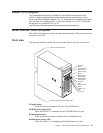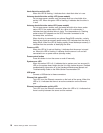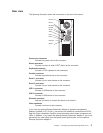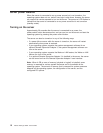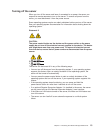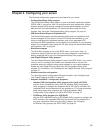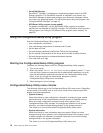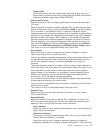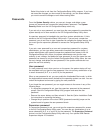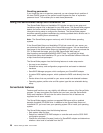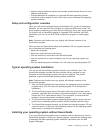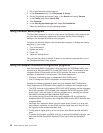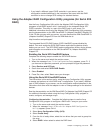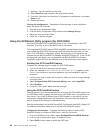–
Product
Data
Select
this
choice
to
view
the
machine
type
and
model
of
your
server,
the
serial
number,
and
the
revision
level
or
issue
date
of
the
BIOS
code
stored
in
electrically
erasable
programmable
ROM
(EEPROM).
v
Devices
and
I/O
Ports
Select
this
choice
to
view
or
change
assignments
for
devices
and
input/output
(I/O)
ports.
Select
this
choice
to
enable
or
disable
integrated
SCSI
and
Ethernet
controllers
and
all
standard
ports
(such
as
serial
and
parallel).
Enable
is
the
default
setting
for
all
controllers.
If
you
disable
a
device,
it
cannot
be
configured,
and
the
operating
system
will
not
be
able
to
detect
it
(this
is
equivalent
to
disconnecting
the
device).
If
you
disable
the
integrated
SCSI
controller
and
no
SCSI
adapter
is
installed,
the
server
will
have
no
SCSI
capability.
If
you
disable
the
integrated
Ethernet
controller
and
no
Ethernet
adapter
is
installed,
the
server
will
have
no
Ethernet
capability.
If
you
disable
the
integrated
USB
controller,
the
server
will
have
no
USB
capability;
to
maintain
USB
capability,
make
sure
that
Enabled
is
selected
for
the
USB
Host
Controller
and
USB
BIOS
Legacy
Support
options.
This
choice
is
on
the
full
Configuration/Setup
Utility
menu
only.
v
Start
Options
Select
this
choice
to
view
or
change
the
start
options.
Changes
in
the
start
options
take
effect
when
you
restart
the
server.
You
can
set
keyboard
operating
characteristics,
such
as
the
keyboard
speed,
and
you
can
specify
whether
the
server
starts
with
the
keyboard
number
lock
on
or
off.
You
can
enable
the
server
to
run
without
a
diskette
drive,
monitor,
or
keyboard.
The
startup
sequence
specifies
the
order
in
which
the
server
checks
devices
to
find
a
boot
record.
The
server
starts
from
the
first
boot
record
that
it
finds.
If
your
server
has
Wake
on
LAN
hardware
and
software
and
the
operating
system
supports
Wake
on
LAN
functions,
you
can
specify
a
startup
sequence
for
the
Wake
on
LAN
functions.
You
can
also
specify
whether
the
integrated
SCSI
controller
or
a
PCI
SCSI
adapter
has
boot
precedence.
If
you
enable
the
boot
fail
count,
the
BIOS
default
settings
will
be
restored
after
three
consecutive
failures
to
find
a
boot
record.
You
can
enable
a
virus-detection
test
that
checks
for
changes
in
the
boot
record
when
the
server
starts.
This
choice
is
on
the
full
Configuration/Setup
Utility
menu
only.
v
Date
and
Time
Select
this
choice
to
set
the
date
and
time
in
the
server,
in
24-hour
format
(hour:minute:second).
v
System
Security
Select
this
choice
to
set
password
settings.
See
“Passwords”
on
page
19
for
more
information
about
passwords.
You
can
also
enable
the
chassis-intrusion
detector
to
alert
you
each
time
the
server
cover
is
removed.
–
User
Password
Select
this
choice
to
set
or
change
a
user
password.
See
“User
password”
on
page
19
for
more
information.
–
Supervisor
Password
This
choice
is
on
the
Configuration/Setup
Utility
menu
only
if
an
optional
IBM
Remote
Supervisor
Adapter
II
is
installed.
Select
this
choice
to
set
or
change
a
supervisor
password.
A
supervisor
password
is
intended
to
be
used
by
a
system
administrator;
it
limits
access
to
Chapter
2.
Configuring
your
server
17



